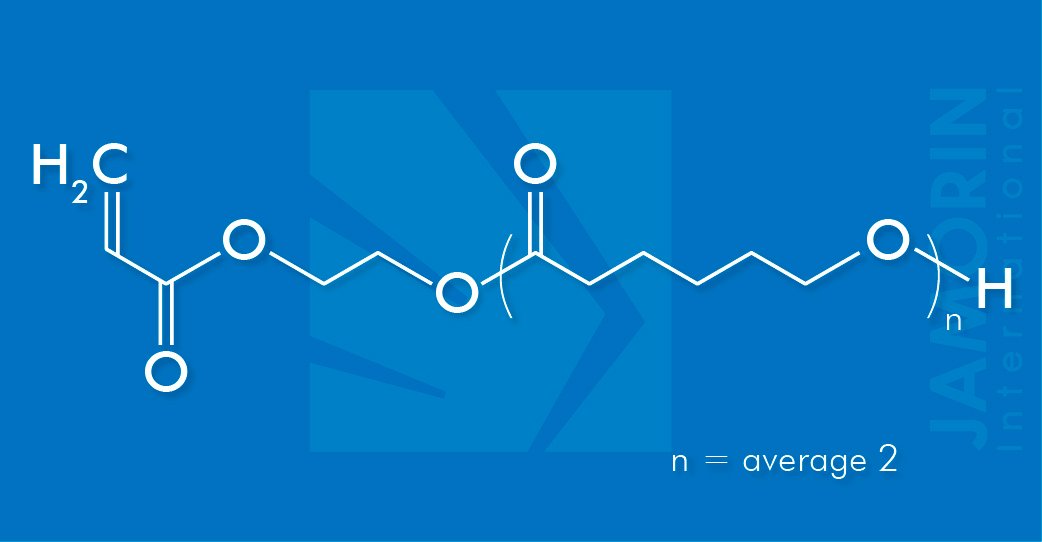C12,8H36O8,6
Hydroxyl value is 163.7 ± 5 mg KOH/g
C12,8H36O8,6
Hydroxyl value is 163.7 ± 5 mg KOH/g
Hydroxyethylcaprolactone Acrylate (HECLA)
Hydroxyethylcaprolactone Acrylate (HECLA) is an ester of Acrylic acid and is used as a raw material component in the synthesis of polymers. Hydroxyethylcaprolactone Acrylate (HECLA) is a caprolactone modified version of Hydroxyethyl Acrylate (HEA), by incorporating an average of 2.8 moles of caprolactone per mole of Hydroxyethyl Acrylate (HEA). Copolymers of Hydroxyethylcaprolactone Acrylate (HECLA) can be prepared with (meth)acrylic acid and its salts, amides, and esters, and with (meth)acrylates, acrylonitrile, maleic acid esters, vinyl acetate, vinyl chloride, vinylidene chloride, styrene, butadiene, unsaturated polyesters, and drying oils, etc.
Hydroxyethylcaprolactone Acrylate (HECLA) is a very useful starting material for chemical synthesis since it easily undergoes addition reactions with a wide spectrum of organic and inorganic compounds.
Product Type: Hydroxyl-containing Acrylate Monomer
Features & Benefits:
- Chemical resistance
- Flexibility
- Hardness
- Crosslinking
- Weatherability
- Adhesion
Applications areas:
- Hydroxyethylcaprolactone Acrylate (HECLA) is also an ideal capping agent for UV curable wear layers on PVC and parquet flooring and offering versatility in UV curable printing inks in food packaging applications.
It is applied in the production of:
- Adhesives
- UV Curables
Chemical Properties:
-
PurityHydroxyl value is 163.7 ± 5 mg KOH/g
-
Acid Valuemax. 4.0 mg KOH/g
-
Water contentmax. 0.1 %
-
Color APHAmax. 100
Physical Properties:
-
Appearanceclear, colorless to pale yellow
-
Physical formliquid
-
Odorcharacter
-
Molecular weight436 g/mol
-
Density1.09 g/cm3 at 25 °C
-
Flash point> 120 °C
In order to prevent polymerization, Hydroxyethylcaprolactone Acrylate (HECLA) must always be stored under air, and never under inert gases. The presence of oxygen is required for the stabilizer to function effectively. It has to contain a stabilizer and the storage temperature must not exceed 35 °C. Under these conditions, the storage stability of one year can be expected upon delivery. In order to minimize the likelihood of overstorage, the storage procedure should strictly follow the “first-in-first-out” principle. For extended storage periods over 4 weeks, it is advisable to replenish the dissolved oxygen content. Storage tanks and pipes should be made of stainless steel or aluminum. Although Hydroxyethylcaprolactone Acrylate (HECLA) does not corrode carbon steel, there is a risk of contamination if corrosion does occur. Storage tanks, pumps, and pipes should be earthed.
Storage & Handling:
In order to prevent polymerization, Hydroxyethylcaprolactone Acrylate (HECLA) must always be stored under air, and never under inert gases. The presence of oxygen is required for the stabilizer to function effectively. It has to contain a stabilizer and the storage temperature must not exceed 35 °C. Under these conditions, the storage stability of one year can be expected upon delivery. In order to minimize the likelihood of overstorage, the storage procedure should strictly follow the “first-in-first-out” principle. For extended storage periods over 4 weeks, it is advisable to replenish the dissolved oxygen content. Storage tanks and pipes should be made of stainless steel or aluminum. Although Hydroxyethylcaprolactone Acrylate (HECLA) does not corrode carbon steel, there is a risk of contamination if corrosion does occur. Storage tanks, pumps, and pipes should be earthed.
A Safety Data Sheet has been compiled for Hydroxyethylcaprolactone Acrylate (HECLA) that contains up-to-date information on questions relevant to safety.
The data contained in this publication are based on our current knowledge and experience. In view of the many factors that may affect the processing and application of our product, these data do not relieve processors from carrying out their own investigations and tests; neither do these data imply any guarantee of certain properties, nor the suitability of the product for a specific purpose. Any descriptions, drawings, photographs, data, proportions, weights, etc. given herein may change without prior information and do not constitute the agreed contractual quality of the product. It is the responsibility of the recipient of our products to ensure that any proprietary rights and existing laws and legislation are observed.
